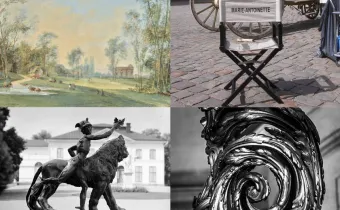A French monument at the heart of European turmoil
A symbol of the Franco-German rivalry that began brewing in the 19th century, the Palace of Versailles was witness to the dawning of the German Empire in 1871, and fuelled Adolf Hitler’s thirst for revenge following the Treaty of Versailles in 1919. As the 1930s drew to a close, tensions were mounting in Europe as the threat of a new war loomed ever larger over the continent. If the Germans succeeded in pushing through to Versailles, would they make the Palace pay for its past?
Episode 1: “May Louis XIV keep watch over Versailles”
By the 1930s, France’s museums were readying themselves for the possibility of a new war. From 1933 on, the Palace’s deputy curator, Charles Mauricheau-Beaupré, drew up a first plan for evacuating Versailles’ collections. By the end of the 1930s, conflict seemed inevitable and the Palace of Versailles arranged for its treasures to be covertly evacuated to a series of secret depot sites. Its “passive defence” plan was under-way. On 25 August 1939, along with the rest of the country’s museums, the Palace closed its doors to the public and dispatched some of its works to the Château de Brissac and Château de Chambord. On 13 June 1940 on the eve of the German troops’ arrival, a mere four men stood watch over a now unrecognisable Versailles.
Episode 2: “Dark days dawn”
In the morning of 14 June 1940, the Germans erupted into Versailles and seized possession of the premises. The next morning, the Nazi flag could be seen fluttering from the Palace’s rooftops. Over the ensuing weeks, German soldiers and officers flooded into the Palace, exploring the site and causing damage along the way. Versailles had fallen to the Third Reich, and the Palace’s future looked uncertain.
Episode 3: “Life goes on”
During the Occupation, the German authorities deplored the way in which the Palace had been stripped and ordered it to be restored. Curators and architects did so to the best of their abilities, while the Palace remained in the grip of the occupying troops. Over on the French side, fears lingered with regard to its fate, especially as the Allies’ bombing began creeping ever closer from 1943 on, and the grounds swarmed with military activity.
Episode 4 : « Versailles is intact: Fountains play again »
25 August 1944: Versailles is liberated by General Leclerc’s troops. As the Allies advanced, the Germans had fled the city the day before. The Palace was alive and well. As the British and American troops poured in, Versailles rose up to meet them, ushering the soldiers into the Hall of Mirrors where the Treaty of Versailles had been signed just twenty-five years earlier. It would take until 1946 for all the artworks and pieces to return home to the museum.
Digital extras
The web series sits alongside a fictional podcast called “Versailles Must Be Saved!”, available from 3 September across all streaming platforms. The podcast centres on a conversation between several protagonists (Jacques Jaujard, Charles Mauricheau-Beaupré, Pierre Ladoué, and Patrice Bonnet) as they discuss the passive defence planned for the Palace as war rumbled on the horizon.
These men and their passion and commitment to the cause ensured Versailles was saved for generations to come.
A second podcast (available in late 2022) will feature interviews with French and German historians on this little-known chapter of Versailles’ past.
All the digital content will be available on a dedicated website that sketches out a comprehensive timeline of the period along with extra content, such as an interactive map of the gardens (showing the passive defence measures taken, grove by grove) and a photo gallery packed full of never-before-seen archive material.
Occupied Versailles: The Palace During World War Two, narrated by Denis Podalydès, member of the Comédie Française, available on YouTube : @Château de Versailles.
Book
The Palace of Versailles web series is underpinned by research conducted by Claire Bonnotte Khelil, art historian, research associate at the Palace of Versailles, and author of the book Le Soleil Éclipsé. Le Château de Versailles Sous l’Occupation (Vendémiaire, co-published by the Palace of Versailles, 2018). In 2021, Claire Bonnotte Khelil organised a conference on how the Île-de-France region’s castles and museums were protected during World War Two. The event took place at the Palace of Versailles, and its proceedings are due to be published.
A first web series DUring the great War
In 2014, the Palace of Versailles produced four episodes on the Great War in partnership with the BnF to mark the centenary of the outbreak of the First World War. This series recounts the role played by Versailles over the course of the conflict: its contribution to the war effort, how its collections were protected, and the signing of the Treaty of Versailles in 1919.
Catch up on the series at: https://en.chateauversailles.fr/discover/history/key-dates/palace-versailles-during-great-war





